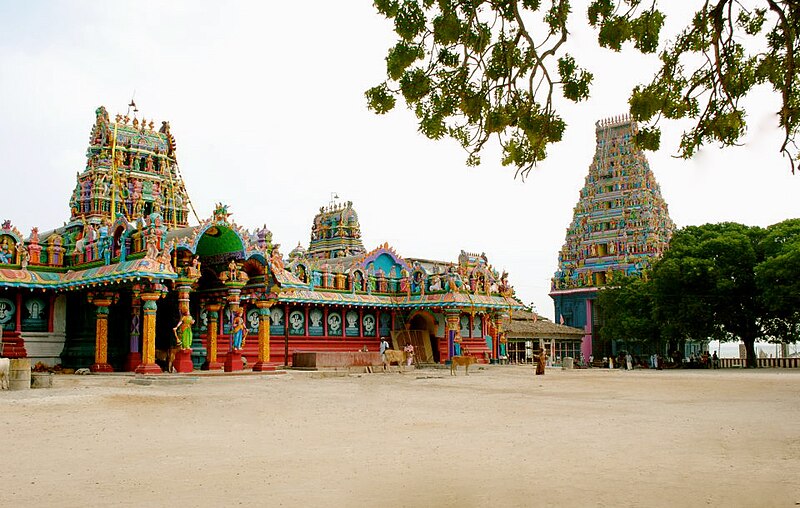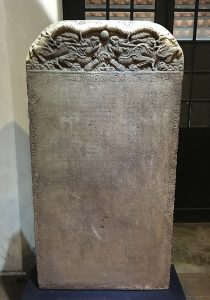OB03182 Nainativu Inscribed Slab of Parakramabahu I
Nainativu Nagapooshani Amman Temple, Sri Lanka
IN03229 Nainativu Tamil Inscription of Parakramabahu I
This inscription is engraved on both sides of a stone slab, which was found lying opposite the entrance to the famous Nākapūṣaṇi-Ammaṉ Temple on the sacred island of Naiṉātīvu in the Jaffna district. Mudaliyar Rasanayagam made an eye-copy of the inscription and published the text as a footnote in his book Ancient Jaffna (1926: 208–209), although his reading was incomplete and contain several errors. Subsequently, the Archaeological Department prepared an estampage of the record in 1949, which Karthigesu Indrapala used to produce a more accurate text and translation in the University of Ceylon Review, 21, no. 1 (1963), pp. 63–70. Large portions of the original inscription have been lost. This is due to the fact that the lower portion of the slab has been broken off and built into the wall of the shrine. Furthermore, the first part of the inscription, written on the obverse of the slab, was obliterated by workmen sharpening their tools on their stone when it lay on the ground outside the temple. Only the text on the reverse side of the slab has survived. Fortunately, the preserved lines contain both the purpose of the edict and the name of the ruler who issued it, although it does not mention the regnal year or date. The record is written in Tamil except for the last two lines, which are in Sanskrit and state that the edict was issued by Deva Parākramabhuja, the emperor of all Siṁhala. The name Parākramabhuja is the Sanskrit equivalent of the Sinhalese Parākramabāhu and may refer to any of the Sinhalese rulers with this name. On palaeographic grounds, the inscription may be assigned to the twelfth or thirteenth century, hence the king question must be either Parākramabāhu I or II, since all the other rulers of that name reigned in significantly later periods. From the contents of the inscription, it can be inferred that the edict was issued by Parākramabāhu I, since the record contains trade regulations concerning wreckages off the port of Ūrāttuṟai (present-day Kayts). The fact that these regulations were proclaimed by the king himself indicates that he was in supreme control of the northernmost parts of the island. Parākramabāhu II did not enjoy such authority over the northern regions, while Parākramabāhu I had control over the entire island. Indeed, there is contemporary and reliable evidence that Ūrāttuṟai was an important naval and commercial centre in his time, plus he was well-known for his organisation of state trading with foreign countries.
OB03181 Mankanai Inscribed Slab of Gajabhahu II
IN03228 Mankanai Inscription of Gajabhahu II
This inscription is engraved on a stone slab, which was discovered in the village of Mānkanai in the Trincomalee town. The slab is now kept in the Archaeological Museum at Anuradhapura. The inscription is in two parts, each comprising of twenty-two lines of writing incised between parallel lines. The purpose of the record is to register the donation for life of certain paddy lanks to one Mintaṉ Koṟṟaṉ, the overseer of the palanquin bearers of the palace. The donation was made by king Gajabhāhu II (r. 1131–1153 A.D.) but it is dated in the forty-third regnal year of his predecessor Jayabhāhu I (r. 1108–1145/6 A.D.) and was inscribed on stone by a local ruler in the Southern Country called Māṉāparaṇa. The practice of dating an inscription from the coronation of a dead king is known from inscriptions. Since Jayabhāhu I took the throne in 1108, the present inscription may be dated to 1150–1151.
OB03180 Panduwasnuwara Slab of Niśśaṅka Malla
IN03227 Panduwasnuwara Tamil Slab Inscription of Niśśaṅka Malla
This inscription was discovered by the Archaeological Commissioner, Senarath Paranavitana, in 1951 at Paṇḍuvasnuvara, otherwise called Parākramapura, which was the capital of the Principality of Dakkhiṇa-deśa for a time during the medieval period. Paṇḍuvasnuvara is situated in the Girātalana Korale of the Devamädi Hatpattu in the Kurunǟgala District, some twenty-two miles from Chilaw on the Wariyapola road. The inscription is engraved on a stone slab, which was found at an ancient site to the south of the Citadel. Its discovery is mentioned in the Archaeological Survey of Ceylon Annual Report for 1951 (p. 6). The record is dated in the fifth year of the Kalinga ruler Niśśaṅka Malla, who is here given the biruda Parākramabāhu. Since this ruler ascended to the throne in 1187 A.D., the date of the inscription is to be placed in the year 1191 A.D. or 1192 A.D. This dating is confirmed by the astronomical data given in the inscription. On the basis of this data, the equivalent date of the record would be either Thursday 7 January 1188 or Thursday 3 January 1191, the second of which does indeed fall in the fifth year of Niśśaṅka Malla. The purpose of the inscription is to record the benevolent deeds of a military general called Matimāṉapañacara alias Kulaṉtey. This general can be identified with Lak Vijayasinha, who is mentioned in the slab inscriptions of Niśśaṅka Malla at Polonnaruva.
IN03214 Laṅkātilaka Tamil Rock Inscription
This inscription is one of three lengthy epigraphs engraved on the rock to the south of the Buddhist shrine of Laṅkātilaka in the village of Rabbēgomuwa in Uḍunuvara, Kandy District. Two extensive areas on the surface of the rock are covered with deeply and carefully engraved writing. The upper stretch contains two fourteenth-century Sinhalese inscriptions arranged one above the other (IN03212 and IN03213). Meanwhile, the present inscription occupies a lower stretch of the rock. It consists of forty-six lines in Tamil and seems to date from a similar time period to the Sinhalese inscriptions. Its contents record grants of land and other donations made to the monastery at Laṅkātilaka by its founder – the minister Senālaṅkādhikāra – and by the inhabitants of the realm. The text ends with imprecations against those who would hinder the continuance of the grant, and exhortations made by the minister to kings and minsters of the present and the future for the maintenance of the shrine. The exhortations are embodied in two Sanskrit stanzas with an expanded paraphrase in Tamil. The same stanzas also feature in the Sinhalese inscription of Bhuvanaikabāhu IV on the same rock (IN03212) and the second is included in the rock inscription at Alavaḷa-amuṇa (IN03217), which registers further grants to the Laṅkātilaka shrine. This would seem to suggest that these stanzas were not specially composed for the present inscription but were instead standard forms for expressing such sentiments in this period.
IN03196 Pālamōṭṭai Slab Inscription
This inscription is engraved on a stone slab, which was discovered by Senarath Paranavitana in 1933. Paranavitana found the slab among the ruins of a Śaiva kōvil at a place named Pālamōṭṭai near Kantaḷāy in the Trincomalee District of the Eastern Province. The architectural style of these ruins suggests that they date from the Poḷonnaruva period – a conclusion which is confirmed by the inscription. The inscription is badly weathered and some letters in the first four lines can only be read conjecturally. Due to the damaged condition of the record, it is difficult to decipher the name of the king in whose reign the record is dated. Senarath Paranavitana initially read the king’s name as Jayabāhu and the regnal year as the eighth (Archaeological Survey of Ceylon Annual Report for 1933, p. 14). However, after consulting with K. V. Subrahmanya Aiyer, Paranavitana revised his reading, taking the king’s name to be Vijayabāhu and the number of the regnal year, which is given in figures, to be forty-two (Epigraphia Zeylanica 4, pp. 192–193). If these readings are correct, the inscription can be assigned to the reign of Vijayabāhu I (r. 1056–1111), although this cannot be accepted with certainty.
The purpose of the inscription is to register donations to the god Śiva in the temple named Teṉ-Kailāsam (the Southern Kailāsam) at Kantaḷāy by a female Brahmin named Nāgaiccāṉi in memory of her husband. The inscription also records that the shrine had the name of Vijayarāja Īśvaram and that Kantḷāy was also called Vijayarāja Caturvedimaṅgalam. The appellation of the shrine suggests that it was founded by or under the patronage of Vijayabāhu I. The chronicles and other inscriptions represent this monarch as a great patron of Buddhism but clearly his zeal for Buddhism did not prevent him from extending his patronage to other faiths practiced by his subjects. The term ‘Caturvedimaṅgalam’ frequently features in South Indian inscriptions, where it is appended to the names of villages inhabited by Brahmins. As it was called Vijayarāja Caturvedimaṅgalam, Kantaḷāy must have had a colony of Brahmins who lived there under the protection of Vijayabāhu I. An inscription of king Niśśaṁka Malla found at the site (IN03105) indicates that Kantaḷāy kept its character as a seat of Brahmins for at least a century longer. In the present inscription, the charitable endowment is placed under the protection of the Veḷaikkāra regiment of Śrī Vikkirama Calāmega. As indicated by the Poḷonnaruva Slab Inscription of the Vēḷäikkāṟas (IN03103), the practice of placing a religious institution and its endowments under the protection of a regiment like the Veḷaikkāras was not unknown.

